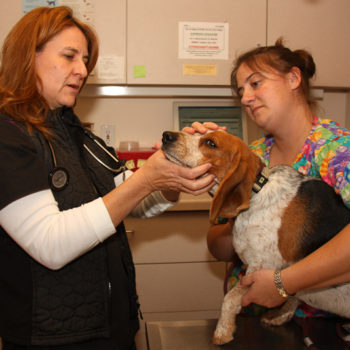Summertime, and the shelter is crowded. That means it’s the season to prevent disease by helping keep pets from entering the shelter at all!
Right now, there’s a confirmed outbreak of the highly contagious H3N2 strain of canine influenza virus (CIV) in Florida, Georgia and six other states, which is combining with kitten season to increase population size and disease risk in many shelters. The most important step shelters can take is to partner with their communities, foster families, rescue groups, and other shelters to ease crowding in the facility.
Dr. Cynda Crawford of the Maddie’s® Shelter Medicine Program at the University of Florida is the researcher who originally identified an influenza virus in dogs. She’s currently working with shelters and veterinarians around the country to help them prevent the introduction of the canine influenza virus and other diseases into their facilities, and respond to outbreaks that have already occurred.
“The most important thing shelters can do is be aware of outbreaks of canine influenza not only in their communities, but in any communities from which they accept dogs,” she said. “They also need to ask anyone surrendering a dog if he or she is coughing, has coughed during the last two weeks, or has been around any dogs who are coughing or seem sick. If the answer to any of those is yes, we recommend you ask them to hold onto their pet for two weeks, the period during which the dogs may be incubating the virus.”
For dogs with confirmed H3N2 CIV, Crawford identified the following critical steps for management of infected dogs and prevention of virus spread to more dogs:
- Isolate all sick dogs for four weeks
- Quarantine all exposed dogs for at least one week, preferably two
- Prevent new dogs entering the shelter from being exposed to dogs who are already sick or who have been exposed to sick dogs
If your shelter doesn’t have the ability to isolate its sick dogs, Crawford is ready with suggestions. “Shelters can transfer their sick and exposed dogs to foster homes that have no other pets for the four-week isolation period,” she said. “They can also transfer them to an organization that has isolation capacity. Another idea is to find an empty building or warehouse for housing sick dogs for four weeks. You can also contact a disaster response group to see if they can provide temporary housing and care.”
She also said it’s critical that shelters be transparent about what’s going on and their need for help. “In my experience, the more open the shelter is about what’s going on with the community, the more help the community offers. Don’t be afraid to ask for foster homes, donations, help from other organizations, or whatever else you need to meet this crisis.”
Learn more about dealing with CIV in shelters and rescue groups here.
Just as Crawford suggested asking people surrendering dogs who might have been exposed to CIV to keep them for a couple of weeks, many shelters now ask people bringing in or calling about orphaned kittens to do the same until they’re old enough to be adopted. This only protects those kittens and their immature immune systems from diseases they might encounter in the shelter, it protects all your cats at the same time.
That’s because a considerable amount of shelter diseases in cats is caused or triggered by stress, and the more cats you’re housing, the more stress they’ll experience. By reducing the influx of kittens in the summer, you’ll likely see a similar reduction in the incidence of feline disease, particularly upper respiratory infections.
Support like that provided by Miami-Dade’s “Milkman” program means shelters give Good Samaritans and people surrendering kittens access to formula, tips on how to care for the kittens, veterinary care if needed, and other supplies during the time they have the kittens. Then they can either support the community members to find homes for the kittens themselves, or take the now-old-enough kittens into the shelter’s adoption program in a planned manner.
As an added bonus, these programs are not only less costly than feeding and raising the kittens in the shelter, they present an opportunity for the shelter to build on their relationship with the community by engaging them in the direct lifesaving of “bottle babies.”
How can you start a program like this. and how will you get your staff and community on board? Maddie’s Fund® and the Million Cat Challenge partnered to present a free webcast, The Milk Man and Wait Until 8 Programs: Saving Cats and Kittens by Thinking Outside the Box, with Miami-Dade Animal Services Chief Veterinarian Dr. Maria Serrano and Director Alex Muñoz. In it, they covered how the program got started and its impact on lifesaving and disease prevention. Strategies they covered included:
- Providing resources, including formula and food, to help community members foster kittens too young for adoption
- Finding out how to ask Good Samaritans to keep the kittens out of the shelter until they’re old enough to be adopted
You can watch the webcast below, or on the Million Cat Challenge YouTube channel.
The bottom line is this: As animal shelters, your mission is to find the best possible outcome for needy pets in your community. That doesn’t mean they should come into your shelter, particularly at times when warm weather is driving increased populations and disease risk. Always be on the lookout for innovations in keeping pets out of your shelter, and share your winning strategies with other groups, too. Let’s make summer a happy, healthy time for pets and people!

